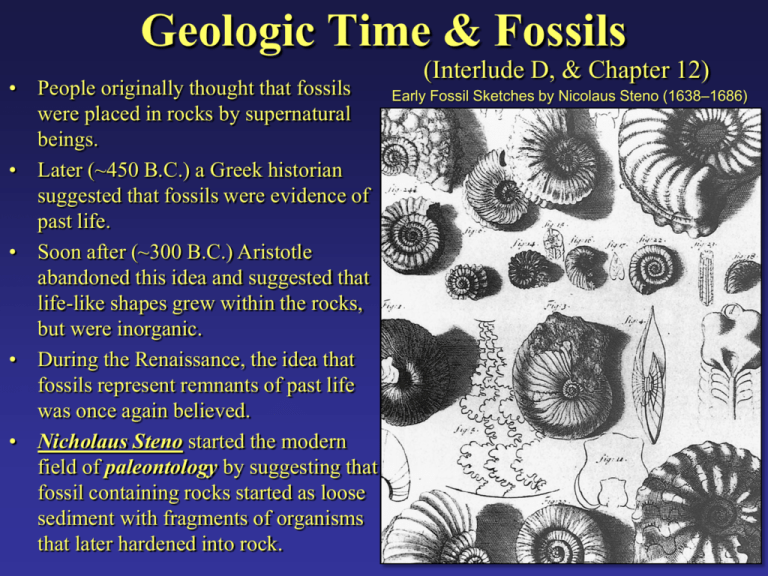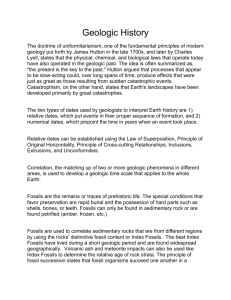AppState: Geologic Time & Fossils
advertisement

Geologic Time & Fossils • People originally thought that fossils were placed in rocks by supernatural beings. • Later (~450 B.C.) a Greek historian suggested that fossils were evidence of past life. • Soon after (~300 B.C.) Aristotle abandoned this idea and suggested that life-like shapes grew within the rocks, but were inorganic. • During the Renaissance, the idea that fossils represent remnants of past life was once again believed. • Nicholaus Steno started the modern field of paleontology by suggesting that fossil containing rocks started as loose sediment with fragments of organisms that later hardened into rock. (Interlude D, & Chapter 12) Early Fossil Sketches by Nicolaus Steno (1638–1686) Types of Fossils • Fossils mainly occur in sedimentary rocks and come in a variety of fossil types • (Body) Fossils – Whole bodies or pieces of bodies of past organisms – E.g. bones, insects preserved in amber/tar, mammoths frozen in ice, etc… • Trace Fossils – Features left behind that are evidence of past life. – E.g. footprints, burrows, etc… Shells in limestone Dinosaur footprint in mudstone Burrows in siltstone Fossil Preservation Not all organisms that die get preserved in rocks. In fact, only a small percentage do, because it takes special circumstances for a fossil to be preserved. • Death in an anoxic (oxygen-poor) environment – Oxygen reacts with organisms and breaks them down, and scavengers may eat the carcass. • Rapid Burial – If an organism dies in an environment that has a high sedimentation rate, it may get buried before it rots or is scavenged. • The Presence of Hard Parts – Organisms with hard parts (bones, shells, etc…) take longer to break down. Soft shelled organisms (e.g. jellyfish) decay very quickly. • Lack of Diagenesis or Metamorphism – Diagenetic and Metamorphic processes (e.g. recrystallization) can destroy fossils • In a typical shallow marine environment, ~30% of organisms have a high preservation potential (hard, sturdy shells), ~40% have a low preservation potential (fragile shells), and ~30% have no sturdy parts and will only be preserved in very rare circumstances. Of the 30% with a high preservation potential, only a few will die in environments that will preserve them. Extraordinary Fossils • Although organisms with soft parts are rarely preserved, there are a number of locations throughout the world that at one time had conditions that were just right for preserving some delicate life forms. • La Brea Tar Pits, Los Angeles – mammals that got trapped in tar seeps were preserved, e.g. saber tooth tigers and mammoths • Solenhofen Limestone, Germany – 150Ma, many rare and well exposed fossils including the oldest bird fossil, Archaeopteryx. • Burgess Shale, British Columbia, Canada – many soft shelled creatures, such as sponges. Researchers have been able to determine the contents of the stomachs of ancient creatures here. A trilobite in the Burgess Shale Archaeopteryx in the Solenhofen Ls. Evolution and Fossils • During a five year cruise (1831-1836) around the world, Charles Darwin conceived the hypothesis that organisms had adapted to their surroundings with less fit organisms dying out over long periods of time through the process of Natural Selection. This hypothesis was novel, because it made many predictions that could be tested. • Since then it has been tested by nearly 200 years of scientific research and no peerreviewed evidence refutes it. It is now known as The Theory of Evolution. • Study of fossil sequences has led to two main ideas about how evolution progresses • (Phyletic) Gradualism – the idea that organisms gradually change over time. Highly linked to Uniformitarianism. • Punctuated Equilibrium – Evolution happens very slowly except during short pulses of evolution, possibly caused by – Climate changes, Mass extinctions, formation of new environments (faulting), the isolation of a species (Galapagos) • Most paleontology research suggests a combination of these two ideas. James Hutton The father of modern geology (1726-1797) • Hutton made observations of geologic structures around Scotland and came up with a the seminal scientific principle used in geology today. • The Principle of Uniformitarianism – Physical processes acting today acted in the past at more or less the same rates and are responsible for the geologic features that we see today. • Furthermore, if this is correct then the Earth must be much older than human history allowed. • Charles Lyell (1797-1875) took the ideas of Hutton and Steno and published a textbook, Principles of Geology, that derived several principles useful for determining the relative ages of various geologic structures. • Relative Age – the age of features relative to each other. • Absolute Age / Numeric Age – A numerical measure of the age of an object (e.g. 13Ma, 500 yrs.) Relative Age vs. Absolute Age • There are two ways of dating geological materials. – Relative ages – Based upon order of formation. • Qualitative method developed 100s of years ago. • Permit determination of older vs. younger relationships. – Numerical ages – Actual number of years since an event. • Quantitative method developed recently. • Age is given as a number. Physical Principles For Determining Relative Ages • Although these principles were laid out in 1857, they are still key to the modern study of geologic structures. We will discuss each in detail, but here’s the list. 1. The Principle of Uniformitarianism 2. The Principle of Superposition 3. The Principle of Original Horizontality 4. The Principle of Original Continuity 5. The Principle of Cross-Cutting Relations 6. The Principle of Inclusions 7. The Principle of Baked Contacts The Principle of Uniformitarianism • “The Present is the Key to the Past!” • Physical processes that we see operating today, also operated in the past at approximately the same rates. • Geologists do recognize that the rates of some processes have changed through time because of factors such as climate change, and occasional catastrophic events (meteor impacts, floods, etc…). • So, in these rocks shown below, these Paleozoic mud cracks in tidal flat deposits (bottom right) and modern mud cracks observed in tidal flats near the Persian Gulf (bottom left) must have formed in a similar manner and in similar amounts of time. Modern mud cracks Paleozoic mud cracks The Principle of Superposition • In a sequence of non-overturned sedimentary rocks, each layer must be younger than the one below because a layer of sediment cannot accumulate if there is no substrate on which it can collect. • Sedimentary rocks that are intensely folded to the point that they are overturned, violate this. The Principle of Original Horizontality • Sediments settle out of a fluid and are subjected to gravity, so they are deposited on relatively horizontal surfaces. If deposited on a slope, the sediment would gradually be transported downhill until a horizontal substrate is reached. • So, when we see folds, we know that rocks have undergone deformation. A sequence of horizontal strata in WI Sediments are deposited on this horizontal tidal flat surface in France The Principle of Original Continuity • Sediments generally accumulate in continuous sheets. If you find a layer that is cut by a canyon or river, then you can assume that the layer once spanned the canyon and was later eroded away. The Principle of Cross-Cutting Relations • If one geologic feature cuts another, the feature that has been cut must be older. The Principle of Inclusions • If an igneous intrusion contains fragments of another rock, the fragments must be older than the intrusion • If a layer of sediment deposited on top of an igneous layer includes pebbles of the igneous rock, then the sedimentary layer is younger. • The xenoliths in an igneous body or the pebbles or sand grains in a sedimentary rock are all older than the rock that they are in. The Principle of Baked Contacts • Igneous intrusions bake (contact metamorphism) surrounding rocks. The rock that has been baked must be older than the intrusion. Geologic Time Animation Fossil Succession • Fossil Assemblage – A group of fossils that is found in a rock. • William Smith (1769-1839), an English engineer in the 19th century, was hired to survey an excavation for a network of canals to transport coal and iron around England. • Smith realized that certain rock layers had distinctive fossil assemblages and that a particular fossil species can be found only in a limited interval of strata. This is called the Principle of Fossil Succession. • Index Fossils - only lived during a very specific time interval. Unconformity – A Gap in Time • Hutton became very interested in the rock outcrop shown below. He soon realized that according to uniformitarianism, the lower rocks must have been deposited and tilted, and then eroded to a flat surface and then the red sandstone was deposited on top of the older tilted beds. Therefore, there must be some period of time that is not represented between the formation of these two units. • Hiatus – A break in the rock record (missing time) • Unconformity – A period in which rocks are not being deposited, possibly involving erosion of existing rocks. – Unconformities come in three flavors… Siccar Point, Scotland Disconformity • • • Disconformity – An erosional surface within a sedimentary sequence. Marks missing time (break in sedimentation) within a sedimentary sequence. Hard to recognize, may have a wavy surface and/or a thin soil present Show unconformity animations Disconformities Angular Unconformity • Angular Unconformity rocks below this type of unconformity were tilted or folded before the unconformity developed. • The rocks above and below this type of unconformity have different orientations Siccar Point, Scotland Nonconformity • Nonconformity – Sedimentary rocks overlie intrusive igneous and/or metamorphic rocks. • Thus the igneous or metamorphic rocks have to have cooled and been eroded to some base level Nonconformity Granite Stratigraphic Columns • Geologists summarize information about the sequences of rocks in what are called Stratigraphic Columns, (or Strat Columns). • Show information about formation name, grain size (horizontal size), and unit thickness (vertical size). • Boundaries between formations are called contacts. Lithologic Correlation • Geologists find the same formations present in locations that are sometimes many kilometers apart. Because of this, we can more easily define the age relations of rock units in different locations. • Correlation – the process by which the age relationships between rock units exposed at different localities are determined. • Units that are present in one location but missing in another are said to “pinch out”. • Formations may also have differing thicknesses in different locations. • This is lithologic correlation and is mainly useful over small-med distances Fossil Correlation • Over large distances geologists can use the presence of certain index fossils, fossils that only are found within rocks of a very limited age, or fossil assemblages to correlate between units that are far apart. • In this case, the Monte Cristo Limestone, found in the mountains north of Las Vegas, contains similar fossils to those observed in the Grand Canyon’s Redwall Limestone. • Therefore, they correlate to each other and must have been formed at the same time. Geologic Maps • Because stratigraphic formations can be correlated, geologists can plot out the locations of geologic formations (and other info, faults, strike&dip) on what are called geologic maps. • Geologic maps show the spatial distribution of rock formations and are an essential tool to geologists. The astute reader can use them to find many geologic structures, such as folds, unconformities, and faults. • Typically geologic maps are overlain upon topographic maps, so that the reader can get a feel for the 3D aspects of the region. Stratigraphic Correlation • National parks of Arizona and Utah. – Formations can be traced long distances. – Overlap is seen in the sequences of rock types. – Overlapping rock columns are used to build a composite. Correlation among rock strata in 3 national parks. The Geologic Column • A composite stratigraphic column exists. – Constructed from incomplete sections across the globe. – It brackets almost the entirety of Earth history. Absolute Dating Absolute Dating – Radioactive Decay • Although since the days of Hutton, geologists have been able to determine the relative ages of geologic structures, it wasn’t until the 1950’s that we became able to determine the absolute age of rocks. • Some elements have unstable isotopes (atoms with the same # of protons, different # of neutrons), which decay and “radiate” energy. • Radioactive elements decay at a constant rate, which can be measured in a lab and are specified in years. • Geologists can now look at radioactive elements within rocks to determine their age. This field is called radiometric dating, or geochronology. Absolute Dating – Radioactive Decay • After a given time, unstable isotopes undergo radioactive decay, which converts them into different elements and releases heat. • These reactions change the atomic number (# protons) of an element and include: – Alpha decay – Ejection of two protons and two neutrons (Helium nucleus) from the nucleus. – Beta decay – Transformation of a neutron into a proton by ejecting an electron from one of the neutrons in the nucleus. – Electron capture – Joining of a proton with an electron to form a new neutron. • The original isotope that undergoes the change is the Parent Isotope • The isotope that is created is called the Daughter Isotope Half-Life • Physicists cannot specify how long and individual isotope will survive, but they can determine how long it will take for half of a group of isotopes to decay. • This time is called the half-life. • So, lets say that some sample contains 16 units of the parent isotope to begin with…what happens as time passes? Useful Isotopes For Dating Rocks • Not all radioactive isotopes are useful for geologists, they must be somewhat abundant in rocks, and have half-lives long enough to record geologic time. • Carbon dating (half-life 5730 yrs.) is only useful for dating very young soils. • To figure out the age geochronologists must then: collect rocks, separate and pulverize the appropriate minerals, extract the parent/daughter isotopes (laser, or with acid), and then analyze the parent/daughter ratio (mass spectrometer). Radiometric Dates: What Do They Mean and What Rocks Can We Date? • At high temps, isotopes in a crystal vibrate so rapidly that chemical bonds can break easily. So, parent/daughter isotopes are meaningless. • The “radiometric clock” starts when crystals become cool enough for both parent and daughter isotopes to become locked in. This temperature is called the blocking temperature. • The blocking temperature is typically significantly cooler than the melting temperature and not all minerals have the same blocking temperature. • In the case of igneous rocks, a radiometric date tells you when the lava/magma cooled to a low temperature. – In a lava flow, different isotopes should yield very similar ages, because flows cool quickly. – In plutons, different minerals may yield different ages since plutons may take thousands to millions of years to cool • In the case of metamorphic rocks, a radiometric date tells you the time when the rock cooled from high grade metamorphism to a low temperature (unroofing). • Most sedimentary rocks cannot be radiometrically dated. – But the ones that can give dates of the clasts and not the sedimentary rock Other Dating Techniques • Geologists also use various other techniques to determine the absolute ages of various geologic units. • Most of these techniques are based on processes that have drastic seasonal variations producing rhythmic layering – Layers in glaciers – Seasonal sediment fluctuations in lakes – Etc… Rhythmic layering in a glacial ice Magnetostratigraphy • Geologists can also look at the magnetostratigraphy, the magnetic polarity preserved in rock layers, to determine ages. • If you encounter a lava flow, you can get a radiometric and magnetostratigraphic age. This is how we know the ages of magnetic reversals of the Earth’s magnetic field. Fission Tracks • In certain minerals, the ejection of an atomic particle during radioactive decay damages the nearby crystal creating a line called a fission track. • As time passes, more isotopes decay and more fission tracks are formed. • Geologists can measure the rate at which fission tracks are produced in the lab. • The number of fission tracks per volume of a crystal represents the age of the crystal. Dating Sedimentary Rocks • Since we can’t directly calculate the numerical age of most sedimentary layers (cosmogenic dating is an exception), geologists rely on bracketing ages of strata with datable igneous rocks. Age of the Earth • Before radioactivity was discovered in 1896, scientists made many estimates of the Earth’s age that were all incorrect and too young. – Sedimentation ~1mm/yr thickest known sediment 20km = 20 Ma Earth. • What about unconformities and metamorphic rocks? • What about the Hadeon? – Oceans started as freshwater now salty = 90 Ma Earth • What about evaporites? • Were oceans always on Earth? – Time to cool something as hot as the Sun into Earth = 20 Ma • What about radioactive heat production, and mantle convection? grrr! Age of the Earth • The oldest rocks that geologists have found are quartzites (metasandstones) from Australia = 4.1-4.2 Ga. • If we assume that most of the objects formed at about the same time from the interstellar cloud (i.e. nebular theory) – Meteorites are 4.57 Ga. So, Earth must be ~4.57 Ga. • We probably won’t find rocks much older than 4.1-4.2 Ga (Hadeon Eon), because the Earth was so hot that most rocks didn’t solidify for the first nearly half billion or so years after Earth’s formation. Geologic Time Scale Geologists have scoured the Earth for the last few hundred years by using the techniques you just heard about have come up with the story of the history of the Earth. Geologic Time Scaled to One Earth Year • Just for fun, lets say that scale down geologic time to one Earth year and note the days of certain events. • Earth Forms - Jan 1st • First Rocks - Feb 21st • First Shelled Invertebrates - Oct 25th • First Amphibians - Nov 20th • Pangaea Formed - Dec7th • First Mammals, Birds, and Dinosaurs - Dec 15th • Dinosaurs Go Extinct - Dec 25th • First Homo Sapiens (Human Ancestors) - Dec 31st • The Last Ice Age Ends - Dec 31st 11:59 P.M. • All Recorded Human History – Last 30 seconds before midnight. – Human history is 0.000001% (1/100 billion) of Earth’s history.








